
William Bunker Tubby was an American architect who was particularly notable for his work in New York City.
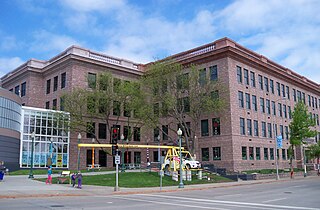
The Washington Pavilion of Arts and Science opened in 1999 and houses an art gallery, concert hall, large-format theater, and science museum in Sioux Falls, South Dakota, United States. Its building, the former Washington High School, is listed on the National Register of Historic Places.

The Sioux Quartzite is a Proterozoic quartzite that is found in the region around the intersection of Minnesota, South Dakota, and Iowa, and correlates with other rock units throughout the upper midwestern and southwestern United States. It was formed by braided river deposits, and its correlative units are thought to possibly define a large sedimentary wedge that once covered the passive margin on the then-southern side of the North American craton. In human history, it provided the catlinite, or pipestone, that was used by the Plains Indians to carve ceremonial pipes. With the arrival of Europeans, it was heavily quarried for building stone, and was used in many prominent structures in Sioux Falls, South Dakota and shipped to construction sites around the Midwest. Sioux Quartzite has been and continues to be quarried in Jasper, Minnesota at the Jasper Stone Company and Quarry, which itself was posted to the National Register of Historic Places on January 5, 1978. Jasper, Minnesota contains many turn-of-the-century quartzite buildings, including the school, churches and several other public and private structures, mostly abandoned.

The Federal Building and U.S. Courthouse, also known as U.S. Courthouse, Sioux Falls, is a historic federal office and courthouse building located at Sioux Falls in Minnehaha County, South Dakota. The building is still in use as a federal courthouse, being the seat of the United States District Court for the District of South Dakota. The structure is listed on the National Register of Historic Places.
East Sioux Falls was a city located in southeastern Minnehaha County, South Dakota located about 6 miles east of Sioux Falls along South Dakota Highway 42 on the Big Sioux River.
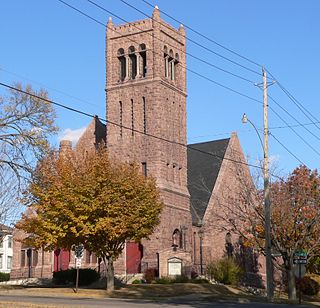
St. Thomas Episcopal Church is a parish church in the Episcopal Diocese of Iowa. The church is located in Sioux City, Iowa, United States. The church building was listed on the National Register of Historic Places in 1984.
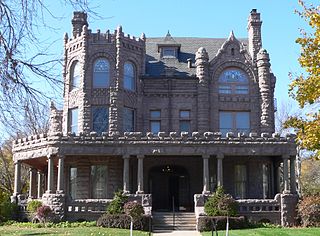
The Peirce Mansion is a 23-room mansion located in Sioux City, Iowa. From 1960 until 2011, the mansion was home to the Sioux City Public Museum with exhibits relating to the history of the region. It is still owned by the Sioux City Public Museum and has now been restored to a Victorian-era appearance. It is open to the public for quarterly open house events and is available for rental.
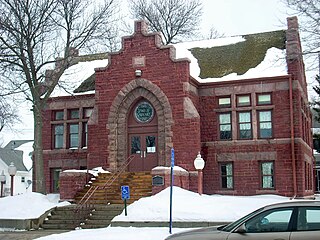
Joseph Schwartz, known also as Josef Schwartz, was a notable architect of Sioux Falls, South Dakota.

Pipestone Public Library in Pipestone, Minnesota, United States, is a Carnegie library that was built in 1904. It was an important work of architect Joseph Schwartz. It was listed on the U.S. National Register of Historic Places in 1980.

Wallace L. Dow (1844-1911), often known as W. L. Dow, was an architect of Sioux Falls, South Dakota. He has been referred to as the "Builder on the Prairie" and was "considered the premier architect of South Dakota in the late 19th century."

The historic Duluth Public Library is a former Carnegie library building at 101 West Second Street in Duluth, Minnesota, United States. It was constructed in 1902 as the first purpose-built facility of the Duluth Public Library. It was listed on the National Register of Historic Places in 1978 for its local significance in the themes of architecture and education. It was nominated for its Neoclassical architecture and association with early community education efforts.

The Old Minnehaha County Courthouse, located at Main Avenue and 6th Street in Sioux Falls, is the former county courthouse of Minnehaha County, South Dakota.

The Rock Island Depot is a historic railroad station located at 201 East 10th Street in Sioux Falls, South Dakota. The station opened in 1886 to serve the Burlington, Cedar Rapids and Northern Railway, a predecessor of the Rock Island. The ashlar and wood building has a Richardsonian Romanesque design with a side-facing stone gable and an octagonal turret. The interior of the station includes a waiting room, a ticket office, and the station agent's quarters. As the railroad network spread through South Dakota, Sioux Falls became the state's primary commercial and transportation hub due to its established station. The station served passenger trains through Sioux Falls until 1970.

Woodbine Public Library, also known as Carnegie Public Library, is located in Woodbine, Iowa, United States. The library was organized in 1907, and it was initially housed in the jail section of city hall. If there was inmate in the jail the public had no access to the library. The city council appointed a board of trustees in 1908 and they applied to the Andrew Carnegie for a grant to build a library building. They received a grant on April 28, 1909, for $7,500. The Eisentraut Company, a Sioux City architectural firm designed the Prairie School building. F. X. White of Eldora, Iowa was the contractor. The building was completed in February 1909, and it was dedicated on March 9 of the same year. This was the first library built in Harrison County.

Charles City College Hall, also known as Old Main, North Hall and Conservatory Hall, is a historic building located on the campus of Morningside College in Sioux City, Iowa, United States. Business leaders in the community established the University of the Northwest in 1889 to provide educational, cultural and economic growth in the city. Completed in 1890, this is the first building constructed for the college and it housed all of the school's functions. The exterior of the Richardsonian Romanesque structure is composed of quartzite. Local architect Charles P. Brown designed the building and John M. Poorbaugh was the contractor. By 1894 the university became a victim of the Panic of 1893, and the property was taken over by the Methodist Episcopal Church who incorporated Morningside College the same year.
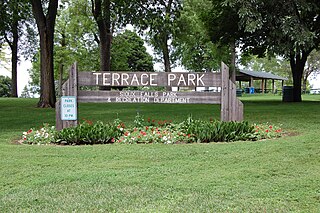
Terrace Park, historically known as Covell Lake Park or Phillips Park, is a 52-acre (21 ha) public park on the shores of Covell Lake in Sioux Falls, South Dakota. Founded in 1916, its modern name is derived from its steep terraces. It was listed on the National Register of Historic Places as Terrace Park and Japanese Gardens in 2015.

The flag of Sioux Falls, South Dakota, consists of a zigzag pattern of thin white and blue lines, which divides an upper blue portion and a lower pinkish-red portion, and a yellow sun in the upper left corner. The zigzag represents the namesake falls of the Big Sioux River. The blue color and the sun allude to the flag of South Dakota. The pinkish-red portion represents the Sioux Quartzite nearby. The upward direction of the design represents the growth of Sioux Falls. The red, white and blue colors included in the flag are also a reference to the flag of the United States while maintaining city and state pride.

The Idaho Falls Public Library, at Elm and Eastern Streets in Idaho Falls, Idaho, was built in 1916 as a Carnegie library and was expanded later. The library operated here until 1977 when it moved a few blocks away. The historic building was listed on the National Register of Historic Places in 1984. It later became part of a new Museum of Idaho. The modern library is located at 457 West Broadway in Idaho Falls.
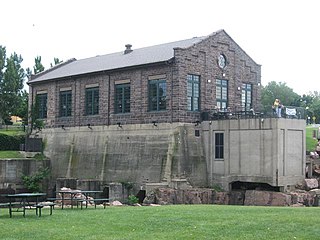
The Sioux Falls Light and Power Hydro Electric Plant, formerly the Northern States Power Building, is a historic building in Falls Park in Sioux Falls, South Dakota. Originally built as a hydroelectric power plant on the Big Sioux River, it now houses the Falls Overlook Cafe. It was listed on the National Register of Historic Places in 1993.

Cathedral Historic District, originally the Sioux Falls Historic District, is a 79-acre (32 ha) area located in Sioux Falls, South Dakota. Named for its centerpiece and key contributing property, the Cathedral of Saint Joseph, the district covers the neighbourhood historically known as Nob Hill, where multiple prominent pioneers, politicians, and businessmen settled in the late 19th and early 20th centuries. These homes primarily reflect Queen Anne and Mediterranean Revival architectural styles. In 1974, the neighborhood was listed as a historic district on the National Register of Historic Places (NRHP); at the time of this listing, there were 223 buildings, not all contributing, within the district's boundaries.




















